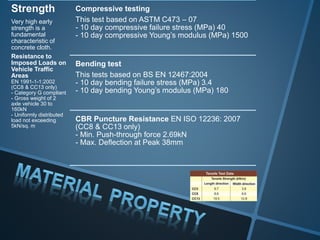concrete cloths
- 7. Strength Very high early strength is a fundamental characteristic of concrete cloth. Resistance to Imposed Loads on Vehicle Traffic Areas EN 1991-1-1:2002 (CC8 & CC13 only) - Category G compliant - Gross weight of 2 axle vehicle 30 to 160kN - Uniformly distributed load not exceeding 5kN/sq. m Compressive testing This test based on ASTM C473 â 07 - 10 day compressive failure stress (MPa) 40 - 10 day compressive Youngâs modulus (MPa) 1500 Bending test This tests based on BS EN 12467:2004 - 10 day bending failure stress (MPa) 3.4 - 10 day bending Youngâs modulus (MPa) 180 CBR Puncture Resistance EN ISO 12236: 2007 (CC8 & CC13 only) - Min. Push-through force 2.69kN - Max. Deflection at Peak 38mm
- 14. Mining Applications Concrete cloth can be used as an alternative to poured or sprayed concrete or as a quick way of erecting strong permanent or temporary blast and vent structures and spall lining. it has been successfully tried in Mpumalanga, South Africa. Bund Lining Earth containment bunds can be quickly lined with Concrete Cloth to provide an efficient, chemically resistant alternative to concrete walling. Dust suppression system in helipad The turbulent air currents created by the helicopter rotor wash drives loose soil particles into the air.

















